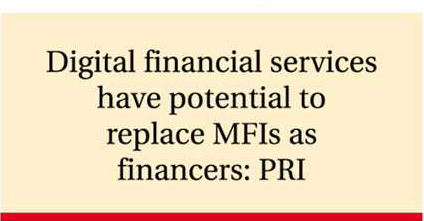
MFIs still major loan sources in rural economy: Study
FE REPORT | Friday, 26 May 2023
Micro finance institutions (MFIs) are still the major and easy sources of loans for predominantly rural households and enterprises despite their exorbitantly high interest rates, according to a study.
According to the study, of the 37 per cent rural households that took loans from financial system, some 66.9 per cent households took loans from MFIs, while the rest took loans from banks, NBFIs, cooperatives and other sources.
The study - "Use of DFS among Households and Firms" - also said 41 per cent enterprises mentioned MFIs as their preffered source for loans.

Policy Research Institute (PRI) Director Dr. Bazlul Haque Khondker conducted the study, which was presented in a training session for journalists at the PRI office in the city.
Dr. Khondker revealed some of the results from the study, which seeks to assess the economic impact of financial inclusion in Bangladesh from a macro-economic perspective.
The study aims to estimate the impact of financial inclusion on growth, poverty, inequality, rural investment, and major macro-economic variables by using Financial Social Accounting Matrix (FSAM).
To collect data on households and firms, a survey was conducted on 1,000 households and 400 cottage, micro and small firms.
The survey collected sample data from eight divisions of the country to obtain a picture on the access to formal financial services, use of digital financial services (DFS) and associated challenges, savings and borrowing behaviour, and sources of financing for both households and firms.
"From our analysis, we can see that the rural households along with cottage, micro and small firms are mostly dependent on microfinance loans, which they can avail without much hassle - but at very high interest rates of around 23-24 per cent or above," said Dr. Khondker.
"On the other hand, the other formal financial institutions, such as banks, NBFIs, and recently some mobile financial services (MFS), are providing loans at much lower interest rates. Therefore, there is a potential for digital financial services to replace MFIs as the sources of financing in the rural economy," he noted.
The preliminary analysis of the survey data shows that around 60 per cent household respondents had MFS accounts, while only 18 per cent had accounts with banks or NBFIs.
It said more men (68.03 per cent) had MFS accounts than women (49.9 per cent).
Those who had MFS accounts, mostly used those for mobilephone balance recharge (79.5 per cent) and/or paying utility bills (50.6 per cent).
In the enterprise/firm survey, 50.25 per cent of the surveyed firms were involved in service-oriented sectors, 31 per cent in manufacturing, and 18.75 per cent in trading.
Only 16.25 per cent cottage, micro and small firms had bank accounts, while 83.75 per cent had no accounts. On the contrary, the survey found that 82.75 per ententerprises were using MFS.
It said the majority of firms (66.74 per cent) used these services for daily business transactions, while a small percentage (5.76 per cent) used those to keep records of business savings, for taking loans for business purposes (5.97 per cent), installment payment of business loans (8.96 per cent), and other purposes (12.58 per cent).
The survey also found that 91 per cent entrepreneurs had to start business with their personal or family savings, or by borrowing from friends or family, without any financial support from formal financial sources/credit.
Most (82.25 per cent) cottage, micro, small and medium enterprises (CMSMEs) stated that they required additional financial support for future growth.
"There is a need for financing the rural cottage, micro and small firms for their business expansion and sustainability. If the MFS and formal financial sources can meet that demand, there is a huge potential for growth in the rural economy," added Dr. Khondker.
bdsmile@gmail.com